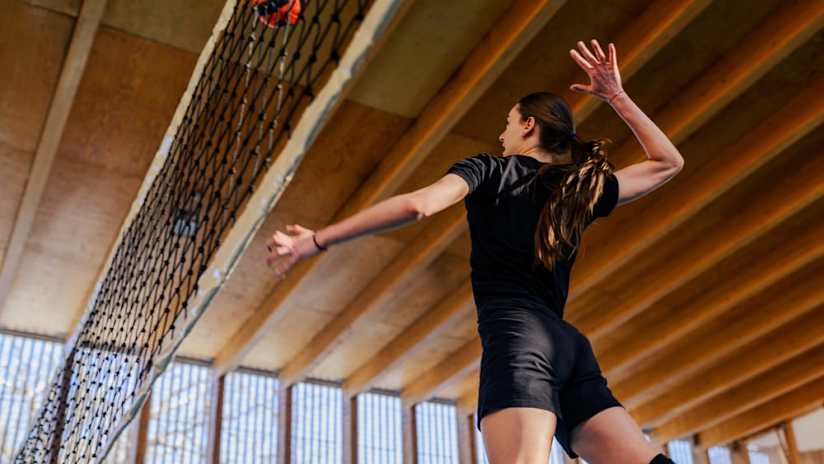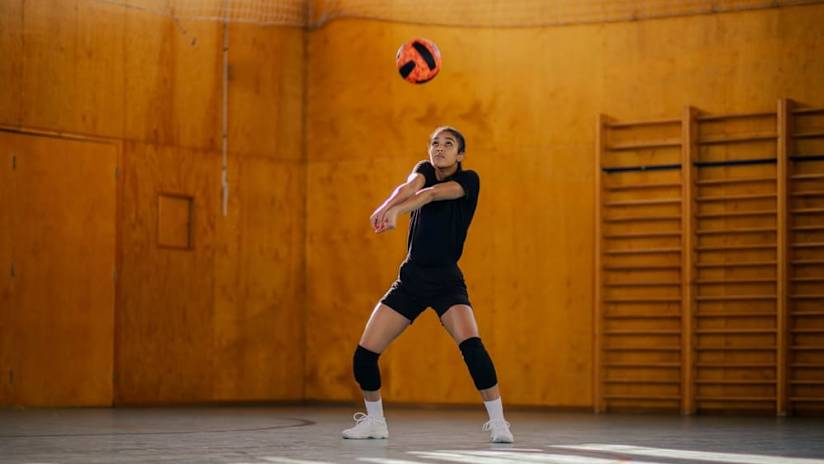One of the fundamental tips for becoming an effective volleyball player is to always be light on your feet and put yourself in a position to pass the ball. Staying focused on the ball while moving around the court is a skill that must be worked on. Strengthening your quadriceps can help you move without bouncing, which will help you track the ball easier.
Form a solid hitting surface with your forearms and extend your arms while locking your elbows and turning your wrist down at the moment of contact with the ball. Use your legs and hips to pass; don't try to use your arms. This will improve your passing consistency. Concentrate on recovering and getting back into position quickly.
Overhead passing is best done with the fingers to direct the ball to your teammates and is effective for hard-driven or deep-hit balls to the back of the court. With balls that are slowly hit or tipped over the net, it can be easier to receive and pass them with your hands.
3. Setting
The second ball should always be aimed at the setter. Setters should try to anticipate where the ball will be passed and be in a position to receive it. By preparing for the ball, the setter should be in a good position to stop and set effectively, with their weight balanced while tracking the ball's movement.
4. Attacking at the Net
Develop consistent footwork using 3 or 4 steps to attack the net. The 3-step approach starts with the left foot for right-handed players and the right foot for left-handed players. The last two steps are the most crucial and you can practice the last two steps until they’re fluid and powerful.
Focus on approaching quickly; this will provide the momentum to maximize your jump height. Swinging your arms back as you leap takes advantage of your elastic energy and can add height to your vertical leap. Bring your arms up as you leap to be in the best position to contact the ball. Aim for contact with the ball in front of your hitting shoulder every time. You want the motion to be as consistent as possible, as consistency helps provide power.
5. Blocking
The best volleyball techniques involve developing the ability to see the entire court and make rapid decisions at the net on where and when to block. Knowing your opponent's hitting habits provides you with an edge in blocking. Practice watching both the setters and hitters to increase your reaction time and get in position to make effective blocks.
The shuffle and crossover steps are used to set yourself up for a block at the net. Try to use the shuffle step the most, as this step provides the most stability and keeps you in position. Try to keep your hips facing your opponents by using these steps to move in front of the net.
Be prepared to jump block by leaping with the fingers spread wide and the thumbs pointed up to prevent jamming. Angle the hands towards the net to try and force the ball into your opponent’s court.
Digging: 5 Effective Techniques
Although digging is one of the most exciting facets of a volleyball game to watch, it's one that players try hard to avoid. Being in the best position to dig means being up on your toes and the balls of your feet, not flat-footed. There are five types of digs that every player should practice:
1. The Collapse
The collapse happens most often when a ball is not hit as hard as expected or hit in an unexpected direction, and the receiver has to make a last-second move for the ball and extend an arm to keep it from touching the ground.
2. The Sprawl
The sprawl technique is used to lunge forward and hit a ball near the ground in front of the player.
3. The Dive
This technique is similar to the sprawl, except it's often performed while airborne at waist height.
4. The Pancake
The pancake is a defensive technique used to prevent a ball from hitting the ground. The fingers are spread and placed between the ball and the ground.
5. Shoulder or Barrel Roll
Defenders often use a rolling technique to either side or forward to hit a ball before it reaches the floor. They use their momentum to complete the roll and help them get back to their feet and in position again.
Subscribe to VBTV
Learn all the tips and tricks practiced by professional volleyball players with a subscription to VBTV. We stream volleyball matches from around the world as well as original VBTV documentaries that offer insight into this fascinating and hyper-competitive international game. Subscribe to VBTV and learn how the pros play it!







